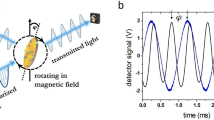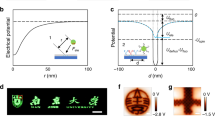Abstract
Synthetic materials capable of selectively recognizing proteins are important in separations1, biosensors2 and the development of biomedical materials3,4,5. The technique of molecular imprinting creates specific recognition sites in polymers by using template molecules6,7,8,9. Molecular recognition is attributed to binding sites that complement molecules in size, shape and chemical functionality10. But attempts to imprint proteins have met with only limited success11,12,13,14,15. Here we report a method for imprinting surfaces with protein-recognition sites. We use radio-frequency glow-discharge plasma deposition to form polymeric thin films16 around proteins coated with disaccharide molecules. The disaccharides become covalently attached to the polymer film, creating polysaccharide-like cavities that exhibit highly selective recognition for a variety of template proteins, including albumin, immunoglobulin G, lysozyme, ribonuclease and streptavidin. Direct imaging of template recognition is achieved by patterning a surface at the micrometre scale with imprinted regions.
This is a preview of subscription content, access via your institution
Access options
Subscribe to this journal
Receive 51 print issues and online access
$199.00 per year
only $3.90 per issue
Buy this article
- Purchase on Springer Link
- Instant access to full article PDF
Prices may be subject to local taxes which are calculated during checkout



Similar content being viewed by others
References
Vijayalakshmi, M. A. Pseudobiospecific ligand affinity chromatography. Trends Biotechnol. 7, 71–76 (1989).
Byfield, M. P. & Abuknesha, R. A. Biochemical aspects of biosensors. Biosens. Bioelect. 9, 373–400 (1994).
Ratner, B. D. The engineering of biomaterials exhibiting recognition and specificity. J. Mol. Recogn. 9, 617–625 (1996).
Ratner, B. D. New ideas in biomaterials science—a path to engineered biomaterials. J. Biomed. Mat. Res. 27, 837–850 (1993).
Brash, J. L. in Biomaterials: Interfacial Phenomenon and Applications, ACS Advances in Chemistry Series, 199(eds Charm, C. P. &Szycher, M.) 3–24 (Technomic, Lancaster, PA, 1991).
Mosbach, K. & Ramstrom, O. The emerging technique of molecular imprinting and its future impact on biotechnology. Bio/technology 14, 163–170 (1996).
Wulff, G. Molecular imprinting in cross-linked materials wit the aid of molecular templates—a way towards artificial antibodies. Angew. Chem. Int. Ed. Engl. 34, 1812–1832 (1995).
Shea, K. J. Molecular imprinting of synthetic network polymers: the de novo synthesis of macromolecular binding and catalytic sites. Trends Polym. Sci. 2, 166–173 (1994).
Steinke, J., Sherrington, D. & Dunkin, I. Imprinting of synthetic polymers using molecular templates. Adv. Polym. Sci. 123, 80–125 (1995).
Cram, D. J. The design of molecular hosts, guests, and their complexes. Science 240, 760–767 (1988).
Mallik, S. J. et al. Towards materials for the specific recognition and separation of proteins. New J. Chem. 18, 299–304 (1994).
Glad, M., Norrlow, O., Sellergren, B., Siegbahn, N. & Mosbach, K. Use of silane monomers for molecular imprinting and enzyme entrapment in polysiloxane-coated porous silica. J. Chromatogr. 347, 11–23 (1985).
Kempe, M., Glad, M. & Mosbach, K. An approach towards surface imprinting using the enzyme ribonuclease A. J. Mol. Recogn. 8, 35–39 (1995).
Venton, D. L. & Gudipati, E. Entrapment of enzyme using organo-functionalized polysiloxane copolymers. Biochim. Biophys. Acta 1250, 117–125 (1995).
Hjerten, S. et al. Gels mimicking antibodies in their selective recognition of proteins. Chromatography 44, 227–234 (1997).
Shi, H., Castner, D. G. & Ratner, B. D. High fidelity template imprinting of cells, proteins and colloidal gold particles. Adv. Mater.(submitted).
Nock, S., Spudich, J. A. & Wagner, P. Reversible, site-specific immobilization of polyarginine-tagged fusion protein on mica surfaces. FEBS Lett. 414, 233–238 (1997).
Crowe, J. H., Carpenter, J. F., Crowe, L. M. & Anchordoguy, T. J. Are freezing and dehydration similar stress vectors? A comparison of modes of interaction of stabilizing solutes with biomolecules. Cryobiology 27, 219–231 (1990).
Lemieux, R. U. How water provides the impetus for molecular recognition in aqueous solution. Acc. Chem. Res. 29, 373–380 (1996).
Paleos, C. M. & Tsiourvas, D. Molecular recognition of organized assemblies via hydrogen bonding in aqueous media. Adv. Mater. 9, 695–710 (1997).
Ariga, K. & Kunitake, T. Molecular recognition at air–water and related interfaces: complementary hydrogen bonding and multisite interactions. Acc. Chem. Res. 31, 371–378 (1998).
Yu, C. & Mosbach, K. Molecular imprinting utilizing an amide functional group for hydrogen bonding leading to highly efficient polymers. J. Org. Chem. 62, 4057–4064 (1997).
Horbett, T. A. Principles underlying the role of adsorbed plasma proteins in blood interactions with foreign materials. Cardiovasc. Pathol. 2(suppl.), 137–148 (1993).
Horbett, T. A. in Techniques in Biocompatibility Testing, II(ed. Williams, D. F.) 183–214 (CRC, Boca Raton, FL, 1986).
Shirahama, H., Lyklema, J. & Norde, W. Comparative protein adsorption in model systems. J. Colloid Interface Sci. 139, 177–186 (1990).
Weaver, D. R. & Pitt, W. G. Sticking coefficients of adsorbing proteins. Biomaterials 13, 577–584 (1992).
Norde, W. & Anusiem, A. C. I. Adsorption, desorption and re-adsorption of proteins on solid surfaces. Colloids Surfaces 66, 73–80 (1992).
Andrade, J. D. in Surface and Interfacial Aspects of Biomedical Polymers: Proteins Adsorption, II(ed. Andrade, J. D.) 1–80 (Plenum, New York, NY, 1985).
Shi, H. & Ratner, B. D. Template recognition of protein imprinted polymer surfaces. J. Biomed. Mat. Res.(in the press).
Bernard, A. et al. Printing patterns of proteins. Langmuir 14, 2225–2229 (1998).
James, C. D. et al. Patterned protein layers on solid substrates by thin stamp microcontact printing. Langmuir 14, 741–744 (1998).
Acknowledgements
We thank T. A. Horbett, D. G. Castner, J. B. Lhoest and R. Luginbuhl for stimulating discussions, S. Golledge and I. Yu for assistance with ESCA and TOF-SIMS measurements, W. Ciridon for assistance in plasma deposition, K. Leach for help in contact angle measurement, and M. Sarikaya and H.K. Fong for access to the tapping mode AFM. This work was supported by NESAC/BIO(NIH) and UWEB(NSF). H.S. thanks the Center for Nanotechnology at the University of Washington for a fellowship.
Author information
Authors and Affiliations
Corresponding author
Rights and permissions
About this article
Cite this article
Shi, H., Tsai, WB., Garrison, M. et al. Template-imprinted nanostructured surfaces for protein recognition. Nature 398, 593–597 (1999). https://doi.org/10.1038/19267
Received:
Accepted:
Issue Date:
DOI: https://doi.org/10.1038/19267
This article is cited by
-
Molecularly imprinted mesoporous silica: potential of the materials, synthesis and application in the active compound separation from natural product
Chemical Papers (2022)
-
Magnetic-molecularly imprinted polymers in electrochemical sensors and biosensors
Analytical and Bioanalytical Chemistry (2021)
-
Biovanillin: production concepts and prevention of side product formation
Biomass Conversion and Biorefinery (2020)
-
A gas sensor array for the simultaneous detection of multiple VOCs
Scientific Reports (2017)
-
Preparation of molecularly imprinted polymers specific to glycoproteins, glycans and monosaccharides via boronate affinity controllable–oriented surface imprinting
Nature Protocols (2017)
Comments
By submitting a comment you agree to abide by our Terms and Community Guidelines. If you find something abusive or that does not comply with our terms or guidelines please flag it as inappropriate.




